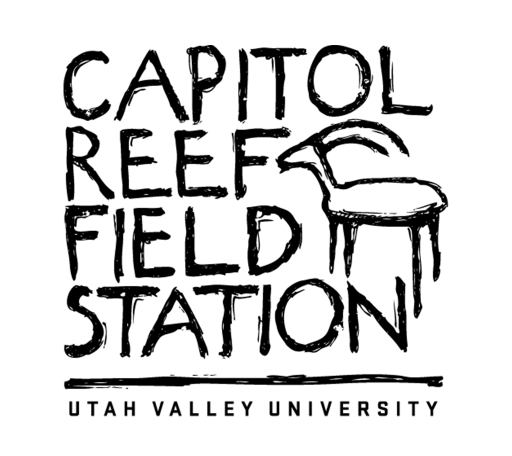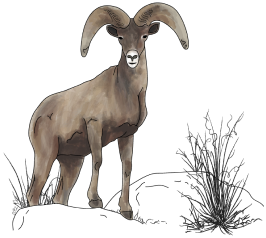Gutierrezia sarothrae (Pursh) Britton & Rusby
Viridiplantae > Streptophyta > Streptophytina > Embryophyta > Tracheophyta > Embryophyta > Spermatophyta > Magnoliopsida > Mesangiospermae > eudicotyledons > Gunneridae > Pentapetalae > astrids > campanulids > Asterales > Asteraceae > Asteroideae > Astereae > North American clade > Solidagininae > Gutierrezia > Gutierrezia sarothrae [1]
![Broom snakeweed located at the Petrified Dunes in Arches National Park [2].](/crfs/images/native-plants/plant-directory/broomsnakeweed-first.jpg)
Broom snakeweed located at the Petrified Dunes in Arches National Park [2].
Perennial subshrub, only woody at the base, 6-90 cm tall, depending on soils and growth conditions. Stems numerous, erect, slender, and brittle with the older stems drying to grayish-tan in color while the new growth is green. Leaves dimorphic, (two distinct forms), the cauline leaves linear to linear lanceolate, scabrous (rough to touch), punctate (with translucent, sunken glands or colored dots), 2-7 cm long and 1-3 mm wide; fascicled (bundled) secondary leaves in the lower axils are entire (not toothed) and glabrous (smooth) to tomentulose (slightly covered with short, wooly hairs). Inflorescence in corymbose heads (flat-topped with the lower pedicels longer than the upper), usually in clusters of 3-10 at branchlet ends, seldom solitary. Involucres (whorl of bracts substending a flower cluster) 3-4.5 mm by 2-3.5 mm, turbinate (shaped like a top). Bracts narrow, acute, with a green thickened tip. Ray flowers 3-7, yellow, 2-5 mm long. Disk flowers 3-8, 2-3 mm long, the pappus (modified calyx) of 8-10 scales. Fruits achenes (dry, one-seeded indehiscent fruit) 1-2 mm long and hairy [3,4,5].
![Broom snakeweed flowers [6]](/crfs/images/native-plants/plant-directory/broomsnakeweed-sec.png)
Broom snakeweed flowers [6]
Broom snakeweed is often confused with Guiterrezia microcephala. However, broom snakeweed has more numerous flowers per head and bears more cone-shaped flowers [5].
“Gutierrezia” honors Pedro Gutierrez, a 19th century botanist of Madrid while the species name, “sarothrae”, is from the Greek “sarum” which means “broom” referring to the broom-like appearance of the stems [7]. The taxonomic history of Gutierrezia has been intertwined with species of Xanthocephalum, a genus superficially similar to Gutierrezia but more closely related to Grindelia and Isocoma [8].
![Gutierrezia sarothrae plant located in South Fork Sevenmile Canyon, UT [9].](/crfs/images/native-plants/plant-directory/broomsnakeweed-third.jpg)
Gutierrezia sarothrae plant located in South Fork Sevenmile Canyon, UT [9].
Broom snakeweed was utilized by Native American peoples for various purposes. The Lakota tribe (South Dakota) drank a decoction of the plant to ease cold symptoms and for dizziness [10]. The Navajo tribe also used to treat dizziness as well as headaches by rubbing the ashes of broom snakeweed on their bodies [11]. They also chewed the plant and applied it to wounds, snakebites, and bug bites or stings to reduce inflammation [12] and even used the plant as a sedative to combat nervousness [13]. The Blackfoot tribe (Great Plains) boiled the roots of broom snakeweed to make a herbal steam to treat respiratory ailments [14] while the Comanche used the plant stems to make brooms for sweeping their homes [15], hence the common name, Broom snakeweed.
![Distribution of Gutierrezia sarothrae at a county level [16].](/crfs/images/native-plants/plant-directory/fremont-cottonwood-fourth.jpg)
Distribution of Gutierrezia sarothrae at a county level [16].
Broom Snakeweed is considered a secure species [17] as it is both abundant and widely distributed.
Often found growing in dry, sandy soils on hills, benches, and occasionally in washes in warm desert shrub, sand sagebrush, pinyon-juniper, and ponderosa pine communities from 760-2,880 m. Broom snakeweed responds to differences in substrates, as they vary from dwarf to tall, the more sandy substrates producing taller plants with larger heads. The plant has a presence of saponins and other toxic substances. Because of this it is considered poisonous to livestock as consumption causes abortion in both cows and sheep [3,5]. Broom snakeweed appears in abundance soon after fire in sagebrush communities [18]. Because it reestablishes rapidly, G. sarothrae often assumes dominance on recently burned sites with cheatgrass (Bromus tectorum) and rubber rabbitbrush (Ericameria nauseosa) [10].
[1] Schoch CL, et al. NCBI Taxonomy: a comprehensive update on curation, resources and tools. Database (Oxford). 2020: baaa062. PubMed: 32761142 PMC: PMKrzy
[2] PMC: PMKrzysztof Ziarnek, K. (2016). Gutierrezia sarothrae in Petrified Dunes Viewpoint . photograph, Arches National Park, Utah, US. C7408187. https://commons.wikimedia.org/wiki/File:Gutierrezia_sarothrae_kz12.jpg
[3] Welsh, S. L., Atwood, N. D., Goodrich, S., & Higgins, L. C. (2018). A Utah flora (5th, revised 2015 ed.). Marcus E. Jones Endowment Fund Monte L. Bean Life Science Museum Stanley L. Welsh Herbarium Brigham Young University
[4] Buren, R. V., Cooper, J. G., Shultz, L. M., & Harper, K. T. (2011). Woody Plants of Utah a field guide with identification keys to native and naturalized trees, shrubs, cacti, and vines. Utah State University Press.
[5] Clark, D. J. (2021). Wildflowers of Utah’s Colorado Plateau: A field guide to wildflowers of Captiol Reef National Park and surrounding areas of Southern Utah. Trails Books, an imprint of Bower House.
[6] Shebs, S. (2008). Gutierrezia sarothrae near the junction of 157 and 158. photograph, Kyle Canyon, Spring Mountains, southern Nevada. https://commons.wikimedia.org/wiki/File:Gutierrezia_sarothrae_6.jpg https://commons.wikimedia.org/wiki/File:Gutierrezia_sarothrae_7.jpg
[7] U.S. Department of the Interior. (2022, December 11). Broom snakeweed. National Parks Service. https://www.nps.gov/arch/learn/nature/asteraceae_gutierrezia_sarothrae.htm
[8] Nesom, G. L. (n.d.). Gutierrezia Lagasca,. Gutierrezia in Flora of North America @ efloras.org. http://www.efloras.org/florataxon.aspx?flora_id=1&taxon_id=114211
[9] Krzysztof Ziarnek, K. (2016a). Gutierrezia sarothrae at the End of South Fork Sevenmile Canyon. photograph, Utah. https://commons.wikimedia.org/wiki/File:Gutierrezia_sarothrae_kz14.jpg
[10] Rogers, Dilwyn J, 1980, Lakota Names and Traditional Uses of Native Plants by Sicangu (Brule) People in the Rosebud Area, South Dakota, St. Francis, SD. Rosebud Educational Scoiety, page 37
[11] Elmore, Francis H., 1944, Ethnobotany of the Navajo, Sante Fe, NM. School of American Research, page 86
[12] Vestal, Paul A., 1952, The Ethnobotany of the Ramah Navaho, Papers of the Peabody Museum of American Archaeology and Ethnology 40(4):1-94, page 51
[13] Hocking, George M., 1956, Some Plant Materials Used Medicinally and Otherwise by the Navaho Indians in the Chaco Canyon, New Mexico, El Palacio 56:146-165, page 151
[14] McClintock, Walter, 1909, Medizinal- Und Nutzpflanzen Der Schwarzfuss Indianer, Zeitschriff fur Ethnologie 41:273-9, page 276
[15] Carlson, Gustav G. and Volney H. Jones, 1940, Some Notes on Uses of Plants by the Comanche Indians, Papers of the Michigan Academy of Science, Arts and Letters 25:517-542, page 522
[16] USDA, NRCS. 2022. The PLANTS Database (http://plants.usda.gov, 09/28/2022). National Plant Data Team, Greensboro, NC USA.
[17] Gutierrezia sarothrae Broom Snakeweed. NatureServe Explorer 2.0. (2024a, May 31). https://explorer.natureserve.org/Taxon/ELEMENT_GLOBAL.2.1252671/Gutierrezia_sarothrae
[18] Mozingo, Hugh N. 1987. Shrubs of the Great Basin: A natural history. Reno, NV: University of Nevada Press. 342 p. [1702]



